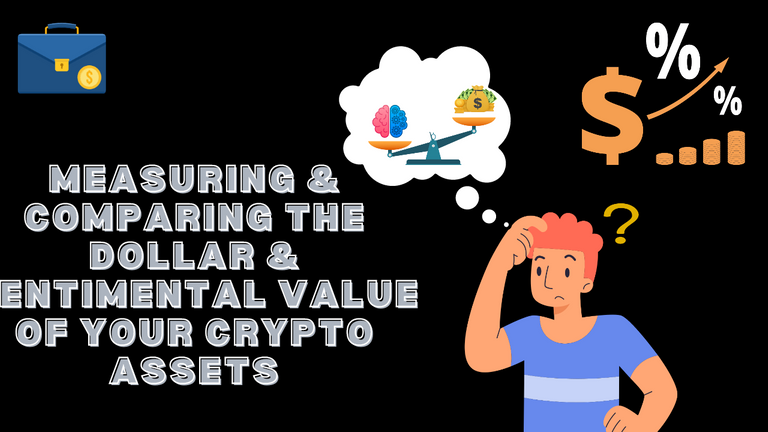
It's not difficult to measure the impact of crypto on one's life. But one of the reasons we try to do so is for the sake of accountability and clarity. A person who invested $500 into let's say Splinterlands is bound to check the increase or decrease of this capital no matter how this basic investment is spread into different assets.
Now, sentimentally, we understand that these assets might dip and react to market pressure hence making them lose their dollar value in the short run, but this might change in the long run. It's the same when we're investing in LEO for Example.
The same dollar value might decrease, but then, the passive income we're earning from owning that Leo stake wouldn't change.
Seeking For Financial Clarity
Sometimes, it becomes difficult to take this into account because we're always quick to measure profit in value and not volume. However, due to the volatility of crypto, volume could easily translate to enormous value depending on the crypto season and loss might just change to profit.
However, for sake of clarity and accountability people often check to see if their investment is doing well price-wise, but this is probably the wrong way to measure profit and loss when it comes to Crypto and this is why sometimes we place sentimental value to our crypto assets especially when the dollar value has been taken away by the change in the crypto season.
Sentimental value is also what I call prospective value. This is the kind of value we tend to place on our assets especially if we see signs that they're going to do well in the short or distant future.
The Concept Of Sentimental Value
For example, a lot of people are beginning to buy and stake SPS in preparation for when the airdrop will be over and then scarcity will ensue. Now, while there's no certainty that SPS as an asset will do well, the sentimental value placed on it, is what makes people ignore the previous price in other to buy even more.
This is the same with holding CUB, POLYCUB, or even DEC. Placing sentimental value on one's assets helps them mitigate the hassles of mental accounting. This is how people tend to cope when there's a ridiculous price dip. For example, yields are what DeFi projects are known for, so there's a reduction in the price value of one's initial investment, they tend to take solace in the yields, hoping it could easily multiply their profits over time.
Without sentimental value, It'll be difficult to see any other form of value to one's crypto assets especially when these assets aren't doing well price-wise.
The Dynamism To Crypto
Nevertheless, we often owe ourselves accountability especially to balance the books and know one's limits. For example, knowing if we're losing or winning often determines if we should keep going or not. But sometimes, the dynamics of crypto don't work this way.
The amount of loss sometimes doesn't necessarily determine one's zeal to keep investing. But sometimes, we often need to see them clearly to know our limits. These limits include tapping into our safety funds. This is the money that cannot be put into crypto because it is invaluable to our personal finance and daily expenditures.
Generally, one of the ways I usually measure the impact of crypto in my life is by checking my wellbeing and measuring the percentage change in my quality of life over time. This is generally because we often lose and win as well, so it matters. We want to make sure we're winning, so is it wrong to do so?
"Time" & The Percentage Change In Your Quality Of Life
We cannot outrightly measure profit especially when we place so many expectations on the dollar value of our assets in the short run. They say profit is made when you buy and not when you sell, while this can be confusing, the focus here is on TIME as an important element of profiteering when it comes to crypto.
While we shouldn't see crypto as a game, it's also important we don't attach our regular day-to-day profit and loss sense of accountability to it. One thing we should understand is that we cannot win it all and at the same time, we cannot lose everything, what matters is making sure one's losses do not exceed what we're gaining.
Even if it's just by 1%. We should learn to accept profit irrespective of the percentage. When we begin to keep tabs on where we've lost, we should understand the ubiquitousness of crypto, our loss might be someone else's gains and vice versa. Rather, keep tabs on the change in your quality of life and the growth rate of your assets by volume.
Interested in some more of my works?
Crypto & The Outrageous Learning Curve: My Splinterlands Journey As A Case Study
Understanding & Adjusting To The Real Purpose Of Motivation
Thematic Expression: African Child (Shot & Edited On My iPhone 12)
How I Create Original Images for My Blog & Why This is Important
Budgeting: Paying Yourself First With Crypto
Establishing Compatibility: A Case For Self-Improvement

@Josediccus, your brother-in-pen & heart
I'm hoping to reach more people who are broken at heart and spirit, so share on any platform or reblog
My Twitter handle
Posted Using LeoFinance Beta

